|
|
Model ST-9XE Self-Guiding CCD camera |
Model ST-9XE and ST-9XEI
High QE CCD Cameras
The Dual CCD ST-9XE and Single CCD ST-9XEI
The Model ST-9XE is a dual sensor, self-guiding CCD camera made for users with longer focal lengths who may want a larger CCD but don't need a megapixel for their application. The ST-9XE is perfect for such things as astrometry and supernova searches with larger telesocpes. It uses a Class 1 "E" CCD with high QE and no column defects. It includes the built-in TC-237H tracking CCD, Remote Guiding Head Port, custom carrying case, water cooling heat exchanger, relay adapter plug, relay cables for self-guiding, and extra software.
The ST-9XEI is the single sensor version with no internal guiding CCD, however it does include the Remote Guiding Head Port for attachment of an optional external guiding head at any time. The imaging CCD is also a Class 1 KAF-0261E with no column defects. Like the ST-7XEI, this single CCD version is an ideal way to get started with a professional quality camera at a reasonable price or for anyone who may already have a guiding solution such as the STV or another CCD camera. It is also an excellent TDI imager. For more details see Alan Holme's recent PDF application note on the subject of TDI imaging with the ST-7XMEI or ST-9XEI cameras. A TC-237H tracking CCD, water cooling and custom case may also be added at any time.
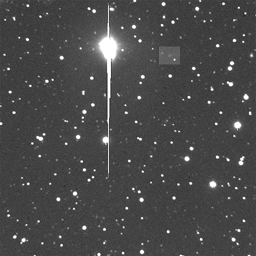 |
Discovery image (reduced) with comet P/1999 X1 Hug-Bell in the highlighted box. Gary Hug writes: "The comet was discovered Dec 10th and has been published in the IAU Circular #7331. Orbital information shows this comet to orbit between Mars and just outside Jupiter's orbit although some distance above the giant planet's path. It's currently about magnitude 18.5, located near the beehive cluster, and was magnitude 18.8 at discovery. The comet will maintain a near even brightness for the next few weeks then gradually fade. It's period is 7.01 yrs. |
The ST-9XE has been a successful camera in its own right among those seeking a large field of view and high sensitivity at a relatively low cost for minor planet and supernova searches with long focal length telescopes. The ST-9XE and ST-9XEI cameras use the KAF-0261E CCD from Kodak with 512 x 512 pixels at 20 microns. The area of the array is about 80% the size of the more expensive ST-8XE and 330% the size of the array used in the ST-7XME. When the ST-9E camera was introduced, the first users' image we received was from two amateurs, Gary Hug and Graham Bell, who discovered a ~19th magnitude comet: Comet P/1999 X1 Hug-Bell. At that time, with a single exception, we are informed that this is the faintest comet ever discovered by an amateur astronomer. Gary and Graham were using a 12" SCT at f/6.3. The discovery was made while blinking 6 minute exposures taken in search of an asteroid. Subsequent 10 minute and 20 minute exposures revealed the comet's tail. Recently we were informed that UK amateur, Mark Armstrong, has discovered no less than 40 supernova using three ST-9E cameras!
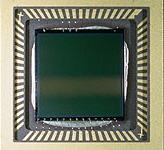 |
KAF-0261E CCD |
TDI (Time Delay Integration, or "Drift Scan" imaging) is particularly interesting because one can image large areas of the sky without guiding so any telescope will do. Basically, one points the camera at an area of sky and turns off the telescope drive to let the stars drift across the field of view. The CCD is clocked in sync with the rate of drift and the resulting image has an exposure time equal to the amount of time it takes the stars to drift across the CCD. Depending on the focal length of the scope this can be many minutes. But there is no periodic error and no guiding error! Furthermore the image can just scroll as the sky moves past so the image file can be 512 x 1000 or 512 x 2000 etc. One gets a deeper image with a more sensitive CCD. In the case of the ST-9XEI the large pixels make it quite sensitive to extended objects and very good wide field astro images can be created with no tracking at all.
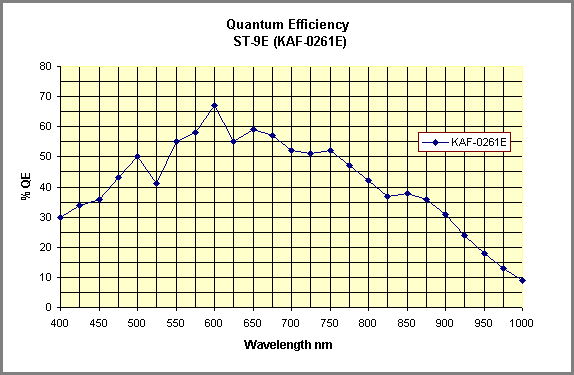 |
Improved Features
Larger Built-In Tracking CCD: The Self-Guiding model uses the TC-237H tracking CCD which is now standard in all of our self-guiding cameras. The TC-237H array is 657 x 495 pixels at 7.4 microns. The TC-237H is 2.7X larger than the TC-211 CCD which means there is a more than double the chance you will find suitable guide stars anywhere you happen to be looking without having to hunt. In the tracking configuration, the TC-237H CCD will normally be binned 2x2 for increased sensitivity. When binned 2x2 the field of view remains 2.7X that of the TC-211 however as the pixel size is increased to 14.8 microns. The user may also use the TC-237H CCD in high resolution (unbinned) mode if desired. ThsSky software from Software Bisque automatically generates finder charts showing the correct placement of the guiding CCD field of view relative to the imaging CCD's field of view. Using this tool to plan your nights imaging is a great compliment to the self-guiding cameras. When guiding with the TC-237H tracking CCD, the imaging CCD spends 100% of its time and quantum efficiency gathering the image. You are not required to compromise by giving up half of the quantum efficiency or by making twice the exposure time as you might with other self-guiding designs.
Remote Guide Head Ready: Both the ST-9XE and ST-9XEI cameras use the same electronics and USB 1.1 interface that is as fast as some competitors' USB 2.0. Moreover, the USB 1.1 interface is easily extended up to several hundred feet with commonly available and relatively inexpensive USB extenders whereas USB 2.0 is not. As of March, 2006, both the single CCD and dual CCD models come with the Remote Guide Head port for attaching an external guiding head. For a comparison of the ST-9XE and ST-9XEI please refer to the chart below.
Upgradeability: The ST-9XEI may be upgraded to a Self-Guiding camera at any time by the addition of the TC-237H tracking CCD.
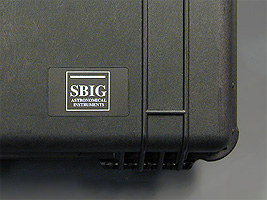 |
| Custom Carrying and Storage Case |
Improved Carrying and Storage Case: The ST-9XE model includes a high quality carrying and storage case made for SBIG by Pelican. The custom cut foam securely holds the camera and power supply with additional spots for accessories, cables, etc. The case is dust proof, water proof, crush proof and carries a lifetime guarantee from the manufacturer. The case is optional for the ST-9XEI.
 |
The 25mm F/16 lens assembly screws into |
Optional Accessory Test Lens: To make testing of the camera easier we have designed a simple test lens that screws into the t-thread front end of the camera. This optional accessory is handy for learning the various camera functions in the day time if you do not have a camera lens adapter. See our Test Lens Product Announcement for more details.
Other Optional Accessories: The ST-9XE cameras support a variety of professional accessories. Each model contains a ROM programmed to support the CFW8A Color Filter Wheel for automatic RGB or LRGB imaging when attached to the camera. Ecah model has an I2C port that supports the new CFW10, ten-position filter wheel. Each model also has electronic relays built-in so that the cameras can be used as autoguiders for film astrophotography or for guiding other CCD cameras. The built-in TC-237H guiding CCD in the ST-9XE model enables the use of both the AO-7 Adaptive Optics Device and the SGS Self-Guiding Spectrograph.
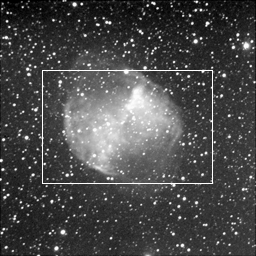 |
Full frame is
the field of view of the ST-9XE at 110 inches focal length. The area inside the white box is the field of view of the ST-7XE at the same focal length. |
The Self-Guiding Spectrograph was designed to give maximum resolution with the ST-7 camera. Several camera lens adapters are available from SBIG for attaching a variety of 35mm camera lenses directly to the ST-9 without the filter wheel for wide field imaging. Third party manufacturers support the ST-9XE and CFW8A color filter wheel combination with camera lens adapters as well.
See the chart below for a comparison of the features of the two models.
Each ST-9XE camera system includes the following:
ST-9XE Comparison Chart |
||
| ST-9XEI | ST-9XE | |
| High QE KAF-0261E CCD | Class 1 | Class 1 |
| Column defects allowed | none | none |
| High Speed USB Interface | l | l |
| Internal shutter for automatic dark frames | l | l |
| Internal ROM for CFW8A control | l | l |
| Regulated thermoelectric cooling with fan | l | l |
| Universal Power Supply | l | l |
| USB Cable | l | l |
| Adjustable t-thread interface block | l | l |
| 2" nosepiece with t-thread base | l | l |
| CCDOPS ver.5 software on CD-ROM | l | l |
| CCDOPS ver.5 manual on CD-ROM | l | l |
| Camera Operating Manual | l | l |
| TheSky v.5, level II software on CD-ROM | l | l |
| TC-237H Tracking CCD (657x495 at 7.4u) | $395 | l |
| Custom Pelican Carrying Case | $149 | l |
| Water Cooling Heat Exchanger | $99 | l |
| ST-7RC Adapter and Relay Cable | $9 | l |
| Printed Camera Operating Manual | $15 | l |
| Printed CCDOPS ver.5 manual | $15 | $15 |
| 1.25" Nosepiece | $49 | $49 |
* Rugged camera body
with new high speed analog and digital electronics
* New High QE Class 1 KAF-0261E imaging CCD with no column defects
* Built-in TC-237H CCD autoguider with 2.7X the area and 10X the sensitivity
of an ST-4
* High speed USB interface (full frame download in about one second).
* New I2C bi-directional expansion port
* New Remote Guide Head Port
* Standard accessory / telescope port
* User rechargeable desiccant plug
* Internal shutter
* 2" Nosepiece
* Cooling Fan - on/off controlled by software
* New heat exchanger design with water cooling capability
* Tripod mount 1/4-20 threaded side plate
* Adjustable t-thread ring
* 15 foot USB cable (third party USB extenders available for up to 500
meters!)
* Telescope interface cable (for autoguiding)
* Universal Power supply
* SBIG's CCDOPS version 5 camera control software
* Software Bisque's CCDSoftV5 camera control and image processing software
* Software Bisque's TheSky version 5, level II
* Operating Manual
* Custom design Pelican carrying case with pre-cut foam for your camera and
accessories
* One Year Warranty Parts and Labor
* Demo CD-ROM with sample images and software
Each ST-9XEI camera includes the following:
* Rugged camera body
with new high speed analog and digital electronics
* New High QE Class 1 KAF-0261E imaging CCD with no column defects
* High speed USB interface (full frame download in about one second)
* New Remote Guide Head Port
* New I2C bi-directional expansion port
* Standard accessory / telescope port
* User rechargeable desiccant plug
* Internal shutter
* 2" Nosepiece
* Cooling Fan - on/off controlled by software
* Tripod mount 1/4-20 threaded side plate
* Adjustable t-thread ring
* 15 foot USB cable (third party USB extenders available for up to 500
meters!)
* Universal Power supply
* SBIG's CCDOPS version 5 camera control software
* Software Bisque's TheSky version 5, level II
* Software Bisque's CCDSoftV5 camera control and image processing software
* Operating Manuals on CD-ROM
* One Year Warranty Parts and Labor
Optional Accessories |
||
|
|
 |
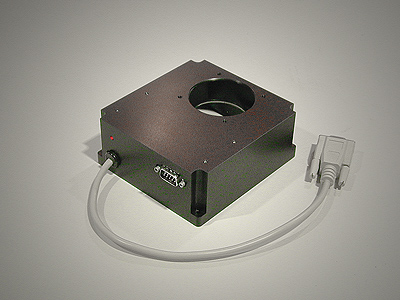 |
| CFW9 Five Position Color Filter Wheel | CFW10 Ten Posisiton Color Filter Wheel | AO-8 Adaptive Optics |
 |
|
|
LRGB, Narrowband and Photometric filters |
Submersible water pump and tubing |
Self-Guided Spectrograph |
Model ST-9XE and ST-9XEI
Typical Specifications
CCD |
|
| CCD |
Kodak KAF-0261E + TI TC-237 |
|---|---|
| Pixel Array | 512 x 512 pixels |
| CCD Size | 10.2 x 10.2 mm |
| Total Pixels | 262,000 |
| Pixel Size | 20 x 20 microns square |
| Full Well Capacity | ~150,000 e- |
| Dark Current | 4e-/pixel/sec at 0 degrees C. |
| Antiblooming | n/a |
Readout Specifications |
|
| Shutter | Electromechanical |
|---|---|
| Exposure |
0.12 to 3600 seconds, 10ms resolution |
| Correlated Double Sampling | Yes |
| A/D Converter | 16 bits |
| A/D Gain | 1.6e-/ADU |
| Read Noise | 15e¯ RMS |
| Binning Modes | 1 x 1, 2 x 2, 3 x 3 |
| Pixel Digitization Rate |
Up to 420.000 pixels per second |
| Full Frame Download | <1 second |
System Specifications |
|
|---|---|
| Cooling - standard |
Single Stage Thermoelectric, Active Fan, Water Assist -45 C from Ambient Typical with water, -35 C w/air only |
| Temperature Regulation | ±0.1°C |
| Power |
5VDC at 1.5 amps, +/-12VDC at 0.5 amps, power supply included |
| Computer Interface | USB 1.1 |
| Computer Compatibility |
Windows 98/2000/Me/XP Mac OS-X / Vista 32 bit |
| Guiding |
Dual CCD Self-Guiding with built-in TC-237 CC |
Physical Dimensions |
|
|---|---|
| Optical Head |
5 inches diameter x 3 inches 12.5 cm diameter x 7.5 deep |
| CPU |
All electronics integrated into Optical Head, No CPU |
| Mounting |
T-Thread, 2" nosepieces included |
| Weight | Approx. 2 pounds/0.9kg |
| Backfocus | 0.92 inches / 2.3 cm |
Price
Price and specifications are subject to change without notice
Revised:
October 06, 2008 12:52:03 PM.
Copyright © 2004 Santa Barbara Instrument Group, Inc. All rights reserved.
Please report any problems with this page directly to the Webmaster